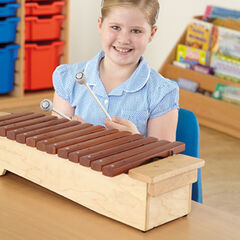Kids’ Music Day is predominantly an American and Canadian event. However, we like the idea of it so much that we thought we’d get on board! The whole point of the day is not to try and create a new batch of professional musicians, (although we’d hope it goes on to produce some); it aims to give children the best chance of success in anything they choose to do in the future.
This comes from the fact that lots of research suggests that there are long term benefits for academic and social success when children participate in music classes and similar activities. (This website is particularly informative and cites lots of professional research). Some of the most celebrated scientists, doctors and entrepreneurs of our time say that music has played a part in their success, Professor Brian Cox springs to mind, for example.
Many teachers say that lack of educational funding, and the push towards the English Baccalaureate, has taken it’s toll on music education in schools. With that in mind, we visited Crich Infant School in Derbyshire who have our Xylophone Value Pack.
They are going to start covering the section of that National Curriculum that states Key Stage 1 children should be able to play tuned and untuned instruments musically.
The children were incredibly excited. Some knew what a xylophone was, others had never seen one. Prior musical knowledge was limited, which is a good thing, as it means we can track how our Xylophones can positively impact their musical development over the year.
Vocabulary development
In this initial lesson, there were lots of opportunities to introduce the class to new words such as ‘xylophone’, ‘pitch’, ‘alto’ and ‘vibration’. Even though they couldn’t all remember all of them by the end of the session, the foundation has been laid and because of the nature of the practical and visual learning, they’re more likely to be able to recall the words when they use the xylophones again in future lessons.
One thing that made me chuckle was the confusion that some of the children had when it came to identifying high, medium and low notes. We, as adults, know that the smaller instruments play a higher pitched note. But, the soprano xylophone was lower to the ground and the bass was bigger and so higher up. Watching back the video of the lesson, I think that is where some of the confusion came from and so I’ve added this in to the free lesson plan below, provided by Paige Farley at Crich Infant School.
Being an experienced teacher, Paige came up with a brilliant way of helping the children remember. She compared the bass xylophone to ‘Daddy Bear’ because he has a really low voice. ‘Mummy Bear’ is the alto because she has a medium pitched voice. That leaves the soprano xylophone as ‘Baby Bear’ because he has a squeaky, high pitched voice. Genius!
You can watch the session here on our YouTube channel and below is the free lesson plan to accompany it.
Activity Plan – Introduction to Xylophones – Year 1
Links to National Curriculum
- Play tuned and untuned instruments musically
- Experiment with, create, select and combine sounds using the inter-related dimensions of music.
Resources
- Xylophones – bass, alto, soprano
- Appropriate xylophone beaters
- Pitch Pole
- Large blanket to cover the instruments and allow for a big reveal
Prior Learning
The children have had access to several untuned instruments in Reception. This is the first time they have had access to Xylophones as a tuned instrument.
Learning Intention
To experiment with the sound of the xylophone and begin to understand high and low pitch.
Activity Input
- Under the cover have the xylophones – what do you think is underneath? Reveal
- What is it? What do we do with the Xylophone? How do we play a Xylophone?
- Explain what is meant by Xylo (from wood) and phone (sound), what do we think the Xylophone is made from?
- Demonstrate to the children how to hold the mallets and how to strike the Xylophone
- Introduce the pitch pole – and demonstrate to the children high and low sounds. Point out that it’s not how low or high the xylophones are in relation to each other in physical size.
- Experiment with the Xylophones inviting different children to play a note and encourage the children to use key vocabulary such as high, low, bass, soprano and alto
- To finish – allow time for the children to experiment with the instruments as this is the first time they have accessed them.
- Recap – can the children identify the Xylophones that have the highest and lowest pitch?
This article was written by our Social Media and Content Manager, Katie Addison, (former Subject Leader of English), in collaboration with Paige Farley, Year 1 teacher at Crich Infant School in Derbyshire.







